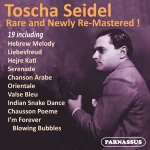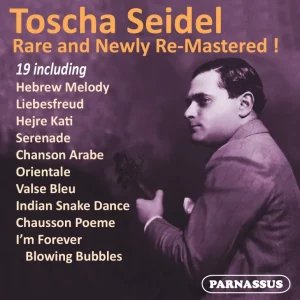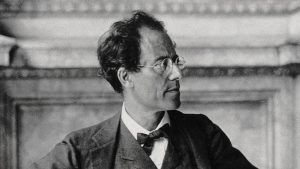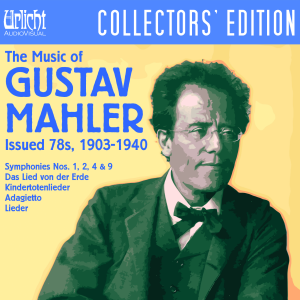
Celebrating the release of Ethan Iverson’s Playfair Sonatas



 \”It’s also illuminating, not only for its compositional diversity but for Cuckson’s extraordinary playing. In featuring violin alone, her virtuosity, dexterity, and command of intonation and phrasing are on full display, and the performances mesmerize. … Cuckson’s playing is always compelling and never less than transfixing. Anyone who might think nearly 100 minutes of unaccompanied violin might be less than engaging will be otherwise enlightened by Világ. If anything, hearing her performing alone allows for an enhanced appreciation of her singular artistry.”
\”It’s also illuminating, not only for its compositional diversity but for Cuckson’s extraordinary playing. In featuring violin alone, her virtuosity, dexterity, and command of intonation and phrasing are on full display, and the performances mesmerize. … Cuckson’s playing is always compelling and never less than transfixing. Anyone who might think nearly 100 minutes of unaccompanied violin might be less than engaging will be otherwise enlightened by Világ. If anything, hearing her performing alone allows for an enhanced appreciation of her singular artistry.”Available for streaming, for download, and on CD!

“It is simply amazing that someone with Tosha Seidel’s enormous talent should have died at the age of sixty-three in complete obscurity after a career that took him all over the world starting at the age of sixteen. Fortunately, this Parnassus release begins to address the neglect the Ukrainian Jewish virtuoso has endured for such a long time.” — Rafael de Acha, All About the Arts
“The lack of [Toscha Seidel’s] recordings in the catalogue is simply baffling and that’s where this succinct 79-minute selection comes in handy. The recordings date from 1918 to 1929 with the exception of the 1945 Chausson. They reveal his vibrant tone and sensual aura as well as his communicative slides (in Achron’s Hebrew Melody). His Kreisler is manly, irreproachably self-confident and oozes tonal lustre and allure, elastically phrased (Schön Rosmarin), vibrantly vibrated and fulsome, with gorgeous double stops (Ave Maria). These are electrically recorded and amongst the best sounding Seidel recordings, revealing the full panoply of his variegated tonal resources. Thereafter there is a long series of predominantly acoustic discs. … If you need a standout piece, amongst many standouts, try Mischa Elman’s arrangement of Ständchen where Seidel’s lustrous, singing tone is under perfect control and beautifully equalized throughout the scale; one of the great violin records. But so many Seidel records are like that; memorable, beautiful and unique in depth of tonal beauty. … This disc fulfils a necessary gap admirably, restoring Seidel’s recordings – but by no means all his recordings – in fine style.” – Jonathan Woolf, MusicWeb
 Leslie Gerber’s enterprising Parnassus Records already was among my favorite historic reissue labels well before Leslie teamed up with my friends at Alto Distribution to make his recordings more easily obtainable. When they approached us about the possibility of doing some audio restoration work involving recording of the great Toscha Seidel, we immediately agreed to undertake the work.
Leslie Gerber’s enterprising Parnassus Records already was among my favorite historic reissue labels well before Leslie teamed up with my friends at Alto Distribution to make his recordings more easily obtainable. When they approached us about the possibility of doing some audio restoration work involving recording of the great Toscha Seidel, we immediately agreed to undertake the work.
We were fortunate to collaborate with veteran collector Raymond Glaspole, who transferred a number of Seidel 78s (from his own collection, in excellent condition) to digital format; the remaining sources were transferred at Urlicht AudioVisual, on loan from other collectors. The electrical studio recordings needed little work, but some of the acoustic 78s presented challenges, yet yielded better results than we had anticipated, with a much lower noise level that sacrifices none of Seidel’s signature tone. Though Chausson’s Poème derives from a broadcast transcription with somewhat limited frequency response and distant orchestral miking, the result of restoration reveals a passionate performance with two artists at their expressive finest.
“Toscha Seidel – Rare and Newly Remastered” is available now. You can find links for streaming and CD purchase here.

This is cross-posted from Synaphaï.
A century ago, Ludwig van Beethoven was by near-universal consensus the most admired composer among lovers and performers of classical music; at the time, little if any consideration was given to the issue of “authentic” performance practice. Keyboard instruments of Beethoven’s era had for the most part been discarded in favor of what we know as the modern piano; orchestral wind, brass, and percussion instruments were similarly superseded by more evolved models. Conductors of the era, including Gustav Mahler, were prone to adjust orchestration to compensate for forces larger and quite different in sound than those of Beethoven’s era.
 Today, there is a strong argument that Mahler occupies the pedestal that had been held by Beethoven during the transition from the 19th to 20th centuries, when his great champions included names such as von Bulow, Paderewski, Rachmaninoff, Weingartner, Toscanini — and, of course, Mahler himself. Likewise, there has been enormous change in orchestral instruments of every family, the biggest being the replacement of gut with metal in the string section, along with technical refinements to wind, brass, and particularly percussion instruments. Today’s orchestra sounds far different than that of Mahler’s era.
Today, there is a strong argument that Mahler occupies the pedestal that had been held by Beethoven during the transition from the 19th to 20th centuries, when his great champions included names such as von Bulow, Paderewski, Rachmaninoff, Weingartner, Toscanini — and, of course, Mahler himself. Likewise, there has been enormous change in orchestral instruments of every family, the biggest being the replacement of gut with metal in the string section, along with technical refinements to wind, brass, and particularly percussion instruments. Today’s orchestra sounds far different than that of Mahler’s era.
The fact that a small but artistically signifiant number of recordings of Mahler’s music were made during the acoustic and “shellac” (electrical pre-LP) recording eras — including several by artists who worked closely with Mahler — gives modern listeners the opportunity to hear these works as they had been sung and played during an era when, contrary to earlier assumptions, their reputation and popularity were on the rise until political and social upheaval – and war – swept Europe in the 1930s.
These early studio recordings, naturally, have given rise to speculation about whether or not it is possible to determine an “authentic” performance style for Mahler.
Several years ago, when I produced “The Music of Gustav Mahler; Issued 78s, 1903-1940” — the first comprehensive anthology of every commercially-issued Mahler 78s released between 1903 and 1940 and listed in Peter Fülöp’s exhausive Mahler discography — my intent was not only to present these recordings in the context of the era in which they were issued and in the best sound possible, but to also offer informed insight into historical, technical, and artistic facts surrounding these recordings in the form of thorough liner notes authored by Sybille Werner.
The set and the accompanying notes were not conceived to answer questions about “authentic” Mahler performance practice — nor for that matter do I believe an answer to the question exists, though one can discern that there were significant artistic and interpretive characteristics unique to the era, particularly in instrumental playing. Additionally, one cannot ignore overall differences among authoritative studio recordings made by Mahler’s conducting colleagues and protégés: Bruno Walter, Willem Mengelberg, and Oskar Fried. Likewise, the voices of Leopold Demuth, Lula Mysz-Gmeiner, and Sara Charles-Cahier, three singers who had sung under Mahler’s direction, shed light not only to the composer’s music but the vocal style and tradition of Mahler’s world, along with the many other singers represented in the set.
I have in recent months received several inquiries about the future availability of the set. I have completed most of the technical work on a follow-up set that will include the remaining 78s and several important recordings issued during the early LP era, but good quality copies of two discs have proven elusive. I expect this situation to be resolved in the next few months, and am speaking with my strategic partners about a short run of the original set once the second volume is completed.
The original run of “The Music of Gustav Mahler; Issued 78s, 1903-1940” — 1000 copies — was warmly received by the press, and my distributors sold out of the set within less than five weeks of its release date. Used copies that turn up on eBay and Amazon command insanely high prices.
Releasing the set as a digital item through online retailers has proven problematic, despite the dogged efforts of my worldwide distributor, Alto Distribution, and my outstanding digital aggregator, Entertainment One.
Some of the major players in digital music for direct sale and download, most notably iTunes, have introduced logistical obstacles that make it next to impossible to make sets with a large number of tracks available for download or streaming.
As a result, I have decided to make the entire set available through a small-scale strategic partner for purchase in lossless download formats: Apple Lossless for iTunes users and flac for most other listeners.
The original English-language liner notes and all German texts with English translations are included in .pdf format.
You can download the entire package here.
You can also stream the set if you are a subscriber to Qobuz.
I will leave any conclusions concerning Mahler’s “authentic” style to you, the listener.

“Eloquent and elegant advocate for knottily complex music” — read David Kettle’s full review at The Strad.

Urlicht AudioVisual is pleased to announce that desde Estudios a Tangos, featuring violinist Elmira Darvarova and legendary tango pianist and arranger Octavio Brunetti, has been nominated for a Latin Grammy®!
The CD was released in September of last year, just days after Octavio’s unexpected death following a brief illness. We are humbled that this disc commemorates a greatly missed champion of tango music at the peak of his abilities in a partnership with one of his very favorite musical collaborators.
desde Estusios a Tangos
Ástor Piazzolla
6 Études tanguistiques • Introducción al Ángel • Night Club 1960 • Milonga del Ángel • Vardarito • Resurreccion del Ángel • Revolucionario
Elmira Darvarova, violin
Octavio Brunetti, piano
Recorded January 19, 2013 at Gill Chapel, Rider University, Lawrenceville, NJ
Engineered and edited by John C. Baker
Produced by Gene Gaudette
Urlicht AudioVisual UAV-CD-5991

 We are in the company of Anna Netrebko, Richard Strauss (as conductor), John Eliot Gardiner, Maria Callas, and Leonard Shure – and quite humbled by the honor:
We are in the company of Anna Netrebko, Richard Strauss (as conductor), John Eliot Gardiner, Maria Callas, and Leonard Shure – and quite humbled by the honor:
This impressive collection of early — very early — Mahler recordings includes symphonies led by the likes of Bruno Walter, Dimitri Mitropoulos, Eugene Ormandy and Willem Mengelberg, often in interpretations more willful and changeable than we are used to today. Memorable weirdness comes in the form of dance-band arrangements of tunes from “Das Lied von der Erde” and “Des Knaben Wunderhorn.”
– Zachary Woolfe
The Music of Gustav Mahler | Issued 78s, 1903-1940
CD Edition: Urlicht AudioVisual UAV-5980
No longer available, limited to an edition of 1000 copies

 Urlicht AudioVisual is deeply saddened to learn of the death of pianist Octavio Brunetti, considered the leading tango pianist and arranger of his generation, at age 39, following a long hospitalization for an unexpected infectious illness.
Urlicht AudioVisual is deeply saddened to learn of the death of pianist Octavio Brunetti, considered the leading tango pianist and arranger of his generation, at age 39, following a long hospitalization for an unexpected infectious illness.
The label was honored to record Octavio, a Grammy®-winning artist, last year with violinist Elmira Darvarova in a program of his original arrangements of music by Ástor Piazzolla, desde ESTUDIOS a TANGOS. The recording will be released on September 2.
 So says music journalist, author, and critic Norman Lebrecht about Elisha Abas at Lebrecht’s blog. Click here to read the entire post and see Abas play Chopin.
So says music journalist, author, and critic Norman Lebrecht about Elisha Abas at Lebrecht’s blog. Click here to read the entire post and see Abas play Chopin.
Abas Plays Brahms: buy here.
Abas Plays Chopin & Yedidia: Buy here.